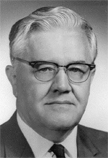Antonin Svoboda
Born October 14, 1907, Prague, Czechoslovakia; died May 18, 1980, Oregon; Czech computer scientist who was instrumental in the development of computer research in his native country through the design and construction of the SAPO and EPOS computers. Rejected by his own country, he returned to the US in 1965 to teach at UCLA.

Education: degree in electrical engineering, Czech Institute of Technology, Prague, 1931; doctor of technical sciences, Czech Institute of Technology, Prague, 1936. [The work which he reported in his thesis was completed at Charles University, Prague.]
Professional Experience: active duty, Czechoslovak Army, 1936-1938; assistant professor, mathematics, Czech Institute of Technology, 1938-1939; consultant, French Ministry of War, Paris, 1939-1940; Radiation Laboratory, MIT, 1941-1946; National Enterprise Aritma, Prague, 1946-50; Central Institute of Mathematics (later the Research Institute of Mathematical Machines), Czechoslovakian Academy of Sciences, 1950-1965; professor, University of California at Los Angeles, 1966-1977.
Honors and Awards: US Naval Ordnance Development Award, 1948.
Antonin Svoboda commenced his work in the field of computing in the mid-1930s while undertaking to improve antiaircraft fire-control devices for the Czechoslovakian Army. Chased out of Czechoslovakia and France by the advancing German armies, he found his way to the US where he joined the Radiation Laboratory at MIT; he was able to continue his work on his computational devices while also working on radar equipment. In 1948 he published a book on his work at MIT entitled Computing Mechanisms and Linkages.
In 1946 he returned to Czechoslovakia with the intention of establishing a computer industry. After several years of development in cooperation with the National Enterprise Aritma on punched equipment, he established a laboratory within the Central Institute of Mathematics (later the Research Institute of Mathematical Machines) of the Czechoslovakian Academy of Sciences. The researchers within the institute, under Svoboda's direction, developed two major computing devices-the SAPO and the EPOS. The former was a classic relay computer equipped with a magnetic drum, somewhat akin to the Harvard Mark III, but with added stored-program capabilities and a unique design involving fault-tolerant systems. SAPO contained three arithmetic units that operated simultaneously on a computation and compared the results to ensure correctness. Realizing the shortcomings of a relay machine, the institute then developed the EPOS machine, which relied on vacuum tubes, germanium diode logic units, delay-line registers, and ferrite core memory. It was also built with fault-tolerant capabilities.
By this time the political climate in Czechoslovakia turned against the use of western technologies, and Svoboda chose to return to the US in order to continue his work. He joined the faculty at UCLA in 1966, teaching computer engineering until his retirement in 1977.
BIBLIOGRAPHY
Biographical
Oblonsky, Jan G., "Eloge: Antonin Svoboda, 1907-1980," Ann. Hist. Comp., Vol. 2, No. 4, 1980, pp. 284-292.
Svoboda, Antonin, "From Mechanical Linkages to Electronic Computers: Recollections from Czechoslovakia," in Metropolis, N., J. Howlett, and Gian-Carlo Rota, A History of Computing in the Twentieth Century, Academic Press, New York, 1980, pp. 579-586.
Significant Publications
Svoboda, Antonin, Computing Mechanisms and Linkages, McGraw-Hill, New York, 1948.
UPDATES
Portrait added (MRW, 2013)
New content Copyright © 2013-2023 by the IEEE Computer Society and the Institute of Electrical and Electronics Engineers Inc.
All rights reserved. This material may not be reproduced or redistributed without the express written permission of the copyright holder.
